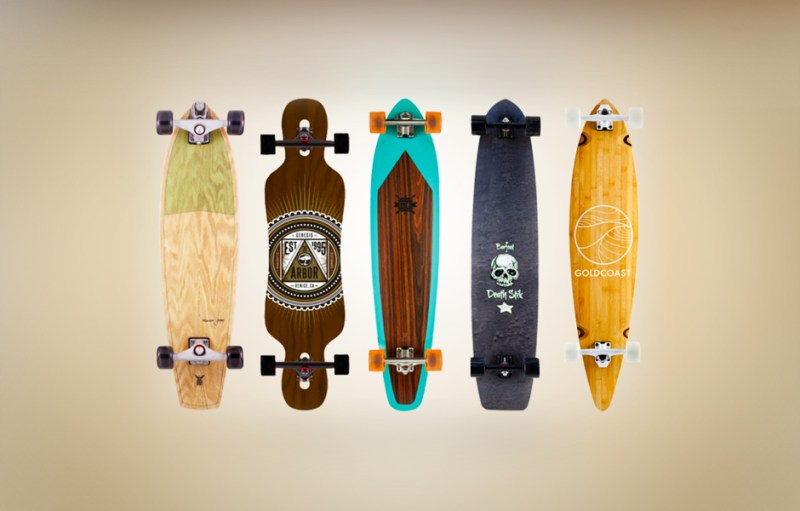
In the five decades since their inception, longboards have moved from the fringes to the mainstream. Bamboo and Maple decks now litter the landscape, sporting a variety of design cuts and sizes catered toward a bevy of notable riding styles. Whether you prefer to bomb downhill or merely cruise — sans a lengthy SUP stick — there are plenty of quality deck manufacturers spanning the globe. As expected, the Manual has a few favorites of its own, from the California-based Maki Drifter to the Aussie-crafted Byron Bay. Wearing a helmet is still entirely on you.
 Maki Signature Drifter — $235
Maki Signature Drifter — $235
Maki is essentially a one-man operation based out of El Sugundo, Calif. Founder Erik Maki initially began the company with quality craftsmanship and sustainable sourcing in mind, quickly developing a line of decks that prove just as versatile as they are modern. He builds each decking using natural fiber laminates and sustainable woods, such as American Red Oak and Baltic Birch, while eliminating the need for fiberglass using laminated wood cores for greater strength and lasting durability. The assorted colors are even sampled from vintage cars, with bio-resin graphics designed to curb scratches and natural fading. Measuring 35-inches long and nine inches at its widest, the Drifter is one of eight attractive builds in the company’s Signature Series. Maki personally hand crafts each board from start to finish himself, so even though the shipping time might be a bit longer than most manufacturers, you can rest assured they’re built with the utmost care and attention.
 Arbor Genesis — $270
Arbor Genesis — $270
Named after the Latin name for Tree, Arbor first began making ripples in the field when it started constructing skate decks from refashioned snowboards back in ’98. The materials and craftsmanship lies in the same tradition as the company’s snowboards, and moreover, the company donates a portion of all sales proceeds to Hawaiian Legacy Forests. Featuring sustainably-sourced deck constructed of maple and koa wood, the 38-inch Genesis represents Arbor’s drop-through line of longboards. Though commonplace, the design allows you to get closer to the ground and eases pushing, while the 9½-inch standing platform provides ample standing room. Whereas the equipped, fiberglass flex provides for a more responsive ride, the added kick tail grants you freestyle versatility when coupled with the recycled-glass grip. Arbor also produces the decks using using eco friendly water-based sanding sealers and a little help from its in-house art department, creating a longboard without a guilty conscious.
 Globe Byron Bay — $190
Globe Byron Bay — $190
Though the Australian-bred Globe essentially began as a skateboard distribution company in the early ’80s, the company has since expanded to include its own line of decks and urban apparel. One of many similar longboards in Globe’s lineup, the Byron Bay sports a standard maple design, gorgeous rosewood veneer, and clear griptape designed to maintain the natural wood inlay. It additionally features a mellow concave topside and convenient kick tail, allowing you to easily maneuver with precision and accuracy while cruising the pavement or sidewalk. Given Globe is a company priding itself in lasting quality and simple maintenance, all of its boards utilize stainless steel hardware, durable urethane risers, and precise bearing spacers. The latter feature is even made of the same shock-absorbent material as the wheels, extending the lifetime of your longboard while maintaining a tight build. And like the iconic surf spot from which it takes its name, it’s the kind of natural beauty you keep coming back to.
 Barfoot Death Stik — $170
Barfoot Death Stik — $170
Having been inducted into Transworld Snowboarding‘s Hall of Fame more than two decades ago, Chuck Barfoot is a man with some experience. As expected, the California-based Barfoot showcases the veteran skateboard maker’s vision for quality and revolutionary design. Maintaining a concave frame and a wide kick tail similar to the aforementioned Maki Drifter for firming planting your back foot, the 44-inch Death Stik is one of Barfoot’s most unique offerings. It’s constructed of a simple Maple ply measuring 9.5 inches at its widest point, but it’s also endowed with a extra narrow nose aimed to lighten the longboard’s respective swing weight when transitioning and cruising about. The clear traction grip additionally ensures the longboard’s trademark skull is always visible, and despite the varying color choices, the 71mm black wheels perfectly compliment the board’s borderline-goth demeanor (for better or worse).
 GoldCoast Classic Pintail Longboard — $175
GoldCoast Classic Pintail Longboard — $175
It’s not surprising GoldCoast remains a staple among longboard manufacturers. The company’s timeless pintail longboard is one of the most heralded in the field, featuring a slight concave deck designed for effortless carving and a bi-axial bamboo laminate crafted for increased durability. The precision-cut, 44-inch decks are made of renewable North American bamboo and maple, and a complete setup comes equipped with GoldCoast’s 70mm wheels for smooth navigation. The most robust portion of the boards run 10 inches in width and the board features cut-in wheel wells in case you want exchange the stock options for bigger offerings. The sleek longboards are also impeccably clean, lined only with with the company’s trademark graphic on the underside. GoldCoast product developer Brock Harris knows his stuff having started Binary Skateboards — and it continually shows throughout the company’s pintail boards.




 GoldCoast Classic Pintail Longboard
GoldCoast Classic Pintail Longboard

